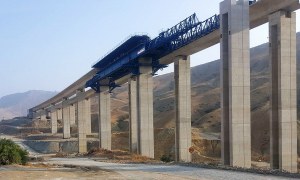🕑 Reading time: 1 minute
Towers of bridges are vertical concrete or steel structures which are extended above bridge decks. It is used in the construction of cable stayed bridge, suspension bridge and hybrid suspension cable stayed structures. In this article, the conceptual design of towers of suspension and cable stayed bridges are discussed in addition to their functions.
Fig.1: Tower of Cable Supported Bridge

Fig.2: Towers of Suspension Bridge
Contents:
Towers of Suspension and Cable Stayed Bridges -Functions and Conceptual Design
Following topics are discussed:- Function of tower of cable suspension bridge or cable stayed bridge
- Conceptual design of towers
- Materials used for the construction of towers
- Forms and shapes of towers
- Erection of towers
Functions of Tower of Cable Suspension Bridge or Cable Stayed Bridge
The main function of towers of cable stayed bridge or suspension bridge is to safely support bridge loads and traffic loads. Towers should be aesthetically pleasing and demonstrate satisfactory survivability performance. Figure-3 and Figure-4 shows free body diagram of suspension bridge and cable stayed bridge and illustrates how towers support bridge loads and traffic loads.
Fig.3 Bridge and Traffic Loads are Carried by Towers

Fig.4: Towers Supporting Bridge and Traffic Loads
Conceptual Design of Bridge Towers
Conceptual design of bridge structure and in this case towers are the most crucial stage of the design of newly constructed bridge and it would be the basis from which final design is achieved. This is because reliability, serviceability, visual appearance and cost of the structure is decided in this step. The significance of tower conceptual design may be greater than other bridge component as it cannot be replaced, support bridge and traffic loads and transfer it to the foundation, determine bridge theme and character. It would be the last image that traveler can remember since it can be seen from all directions. The basics and the focus of conceptual design of towers and the bridge structure in general should reach four crucial conditions that controls the success of the final product. So, towers should be reliable, serviceable, aesthetically pleasing and cost effective. The construction of the towers should be simple and require lowest possible maintenance. The conceptual design of tower bridges would be discussed in the following sections and light will be shed on three main aspect of this bridge component including materials used, shape and form of the tower and construction of the tower.Materials Used for the Construction of Towers
There are three main types of materials which might be selected for the tower constructions involves steel, reinforced concrete and timer. The first two materials can be used for building towers of long span cable stayed and suspension bridge whereas the latter is only applicable for pedestrian bridge.
Fig.5: Steel Tower for Bridge
The type of material that may be used for tower construction should be decided at conceptual design stage and several factors should be considered during decision making process. For example, construction budget for each material should be nearly computed and compared at conceptual design stage. There are different parameters that affect the cost of each material such as equipment availability, market situations, experience of contractor, design details and conditions related to the project site. Maintenance cost and frequency of its need should be considered if the life cycle cost is assumed to be a decisive factor. Therefore, the combination influence of aforementioned factors would specify economical material. The weight of steel towers is less than reinforced concrete tower weight, so the load on foundation will be smaller and consequently foundation cost would be lesser. Not only does steel tower is more ductile and flexible but also need short amount of time to erect. Nonetheless, it is required to conduct paint maintenance for steel towers regularly. Regarding concrete tower, it is designed and constructed as hollow shaft in majority of cases to use smaller quantity of concrete and reinforcements and decease self-weight.
Fig.6: Concrete Tower Bridge
Forms and Shapes of Towers
There are different forms and shapes of towers which can be selected during conceptual design stage. The height of towers in cable stayed bridge structure is equal to 0.2 multiply major span length plus girder depth and clearance to the foundation. This height is approximated and the final values would be decided at final design phase. There are various forms of towers that can be used in cable stayed bridge and these are:Single Shaft Tower
It is the simplest type which is usually vertical and rarely inclined, and mostly adopted for two-way traffic bridge. Single tower should be offset outside of the convex curve in the case of curved roadway and sloped transversely to support curved deck sufficiently.
Fig.7: Single Tower Cable Stayed Bridge

Fig.8: Inclined Single Tower
Two Vertical Shaft Towers
It is composed of two stands which may or may not joined with cross strut, on both sides of the roadway and two lines of cables are used with such form of tower.
Fig.9: Two Vertical Shaft Tower Form
Two Vertical Shaft Tower Offset Above the Roadway
It is composed of two vertical shaft tower that offset above the roadway and these two vertical shafts are joined together by horizontal strut and increase tower safety. This form permits the cables to line up in vertical plane and to be fastened to the girder.
Fig.10: Two vertical shape towers connected by horizontal strut and consequently increase its stability
Other forms and shapes of cable stayed or suspension bridges include two shafts of cable-stayed bridges can be inclined inward toward each other to form a modified A-frame or inclined to bring the shafts tops together to form a full A-frame, modified diamond vertical tower and the A-frame can be extended with a single vertical shaft forming an inverted Y shape.

